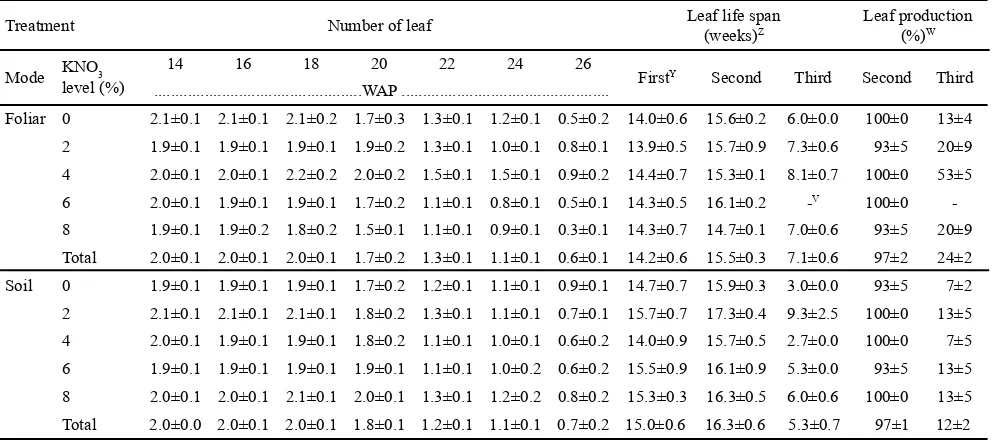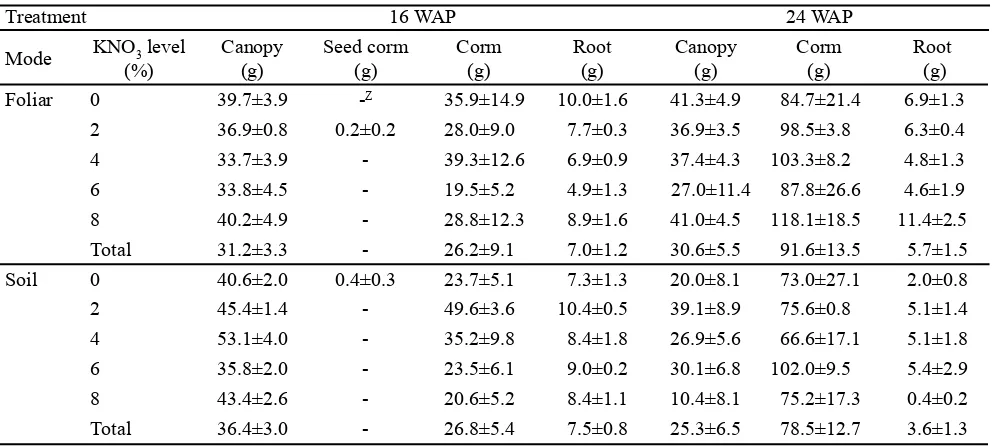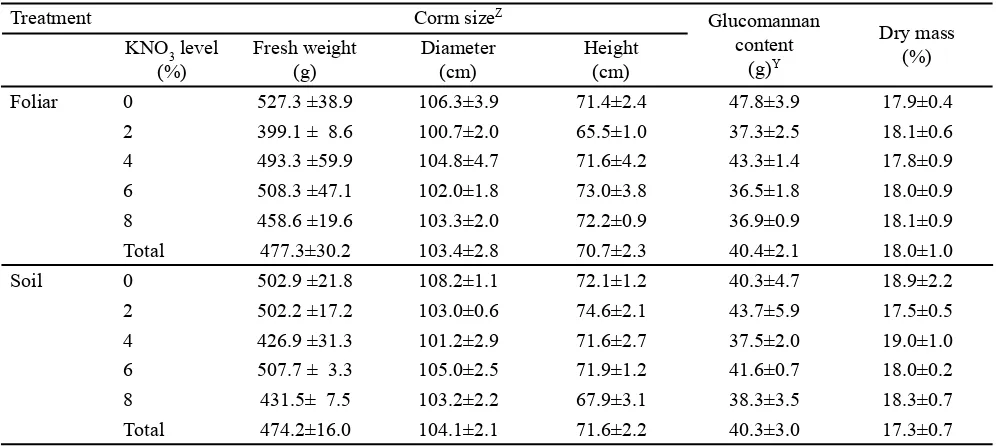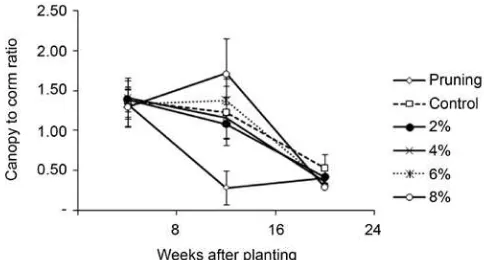* Corresponding author. e-mail: [email protected] INTRODUCTION
Indonesian konjac or iles-iles (Amorphophallus muelleri Blume syn. Amorphophallus oncophyllus) is currently a new export commodity to China and Japan. Annually, about 300 ton dried-corms are exported. The A. muelleri is native to Indonesia (Sugiyama and Santosa, 2008) and its corm contains glucomannan ca. 72% on a dry weight basis (Zhang et al., 2010). Glucomannan is widely used in beverages and food industries, as well as medical purposes (Fang and Wu, 2004; Sugiyama and Santosa, 2008), paper making, textile and crude oil industry (Nishinari, 2000) and ethanol production (Kusmiyati, 2010).
In Indonesia, the corms were mainly collected from wild plants in the forest in Java, Sulawesi and Flores islands. Recently, A. muelleri has been introduced to forest timber companies to reduce the illegal logging and increase villager income (Santosa et al., 2003; Sugiyama and Santosa, 2008). A. muelleri becomes important crops in intercropping system because tolerant to shading (Santosa et al., 2006; Sugiyama and Santosa, 2008), adaptive with low fertilizers and pesticides inputs, and low investment (Santosa et al., 2003).
In agroforestry in East Java, productivity of A. muelleri was 6-10 ton fresh tuber ha-1 year-1, although it was estimated
that potential yield is 40 tons ha-1 year-1 (Santosa et al., 2003;
Sugiyama and Santosa, 2008). The low productivity might be due to low input of chemical fertilizers and pesticides KNO3 Application Affect Growth and Production of Amorphophallus muelleri Blume
Edi Santosa1*, Siti Halimah1, Anas D. Susila1, Adolf P. Lontoh1, Yoko Mine2, and Nobuo Sugiyama2 1Faculty of Agriculture, Bogor Agricultural University, Jl Meranti Kampus IPB Darmaga, Bogor 16680, Indonesia
2Faculty of Agriculture, Tokyo University of Agriculture, Funako, Atsugi, Kanagawa 243-0034, Japan
Received 11 July 2013/Accepted 10 October 2013
ABSTRACT
Application of KNO3 has been assumed able to increase productivity of Amorphophallus muelleri Blume. The purpose of this study was to clarify the effects of KNO3 solution on the productivity A. muelleri. One-year-seed corms of 100-125 g were planted in plastic pot placed under shading net with light intensity reduced by 50% during rainy season (September 2010 to April 2011) in Bogor, Indonesia. Five levels of KNO3, i.e., 0, 2, 4, 6 and 8% (m/v) were applied through foliar and soil sprays twice a month started at 12 weeks after planting. Results showed that application of KNO3 significantly prolong vegetative period and increased number of leaves. KNO3 at level 4% was optimum when applied through foliar application. Application of 4% KNO3 through foliar spray significantly enhanced larger plant growth than similar concentration applied through soil. This result suggested that the effectiveness of fertilizer through foliar application by using 4% KNO3 might be increased if leaf browning could be restricted. Browning was more prominent in old leaves than the young ones, thus, further observation for determining appropriate time of application is important.
Keywords: Foliar application, Indonesian konjac, potassium nitrate, vegetative growth
ABSTRAK
Pemberian larutan KNO3 diduga dapat meningkatkan produktivitas tanaman iles-iles (Amorphophallus muelleri Blume). Penelitian bertujuan mempelajari pengaruh pemberian larutan KNO3 terhadap produktivitas A. muelleri. Umbi utuh umur satu tahun dengan bobot 100-125 g ditanam dalam polibag yang ditempatkan di bawah naungan paranet 50% pada musim hujan (September 2010-April 2011) di Bogor, Indonesia. Lima taraf larutan KNO3 yaitu 0, 2, 4, 6 dan 8% (b/v) diberikan melalui daun dan melalui tanah. Larutan diberikan 2 kali sebulan mulai 12 minggu setelah tanam (MST). Hasil menunjukkan bahwa pemberian KNO3 nyata mempengaruhi pertumbuhan tanaman, khususnya meningkatkan jumlah daun dan memperpanjang masa vegetatif. Pemberian KNO3 pada taraf 4% memberikan pengaruh tertinggi jika diberikan melalui daun. Pemberian KNO3 taraf 4% memberikan pertumbuhan yang lebih tinggi jika diberikan melalui daun dibandingkan melalui tanah. Secara umum, tidak ada pengaruh nyata pada pertumbuhan tanaman akibat pemberian dosis KNO3 yang diberikan melalui tanah. Penelitian berimplikasi bahwa pemberian pupuk KNO3 melalui daun pada taraf 4% dapat ditingkatkan efektivitasnya jika kerusakan pada anak daun dapat diminimalkan. Kerusakan daun cenderung meningkat pada daun tua, oleh karena itu, studi lanjut perlu dilakukan terkait waktu aplikasi yang tepat.
(Bhagavan et al., 2008; Zhang et al., 2010). Sugiyama and Santosa (2008) and Santosa et al. (2011) recommend application of 10 tons manure, 50 kg N, 60 kg P2O5 and 100 kg K2O ha-1 for Amorphophallus growing.
In order to increase productivity in agroforestry, some farmers have applied fertilizers, mainly nitrogen. They usually spread nitrogen fertilizer (urea®) in the field one to two times during growing season, because soil application was restricted by dense planting distance (Santosa et al., 2003). However, many farmers reported that leaves became damage due to some urea® granules stick on leaves that it caused desiccation. Therefore, to avoid leaves damage some farmers modified urea® application by using foliar spraying (Sugiyama and Santosa, 2008). However, the effectiveness of fertilizer application through foliar spray had not been clarified yet.
Side-dressing of NK fertilizers application on A. muelleri had revealed inconsistent results (Sumarwoto and Widodo, 2008; Santosa et al., 2011), therefore, Santosa et al. (2011) has concluded that root might have low ability to utilize nutrients, mainly potassium. Thus, foliar application of potassium may correct deficiency. KNO3 was used because it was the most efficacious form of K for foliar application (Howard et al., 1998) and able to control disease (Bhuiyan et al., 2007). In our preliminary study, foliar spraying 2 to 4% KNO3 solutions increased growth of seedling. Bhagavan et al. (2008) reported that foliar application of KNO3 at rate 2% (m/v) on A. paeoniifolius increased tuber weight and yield, but did not affected morphological characters of plant. Thus, objective of this experiment was to clarify the effect of KNO3 application on growth of A. muelleri.
MATERIALS AND METHODS
Experiment was conducted at Leuwikopo Experimental Farm IPB, Darmaga (260 m above sea level) using soil of Latosol Darmaga (pH 5.2) from September 26, 2010 to April 12, 2011. The soil had a low amount of total N (0.12% by Kjeldahl method), very low available phosphorus (5.9 ppm of Bray I method) and a low amount of exchangeable potassium (0.1 ppm). Virgin soil was composed of sand: silt:clay as 13.13%: 22.06%: 64.79%. Temperature during experiment was 25.6 oC on average with relative humidity
85 to 88%.
Pot experiment was carried out using randomized complete block design (RCBD) with two factors, i.e., KNO3 level and mode of application. Commercial KNO3 fertilizer that contained 15% nitrogen, 14% K2O, 18% Na, and 0.05% B was used. Treatments consisted of five levels of KNO3, i.e., 0, 2, 4, 6 and 8% that applied onto two separate blocks trough foliar spray or soil application with three replicates. In each replication, 5 plants were observed. Pots were arranged in a triangle distance 60 cm x 60 cm x 60 cm. The plants were grown under the shade from planting until harvest. Light intensity was maintained (50% light intensity of full sunshine) by spreading black net at height 1.7 m.
Two weeks prior to planting, a 10 kg virgin soil was mixed with 1 kg of goat manure in a polyethylene bag (50
cm x 50 cm). A one-year-old corm which was collected from seedlings in June 2010 was planted at a depth of 5 cm below soil surface on September 26, 2010. Seed corms of 21.3±3.7 g with diameter 3.7±0.4 cm were planted. At planting, seed corms had sprouted with a main bud being 1 cm high. Basal fertilizer was applied 4 weeks after planting (WAP) at the rates of 2.0 g N, 3.0 g P2O5 and 2.0 g K2O per plant, additional 2.0 g N per plant was applied at 8 WAP followed recommendation of Sugiyama and Santosa (2008). At planting, 2 g of pesticide (Carbofuran 3%) was applied per plant.
KNO3 treatment was started at 12 WAP with interval 2 weeks until most plants entered dormancy. Control plant received only water not KNO3. For KNO3 treatments, KNO3 solutions at concentration of 2, 4, 6 and 8% (m/v) were applied at the rate of 30 mL plant-1 (850 L ha-1) for either
foliar or soil spraying. Watering was applied every day if there is rainfall less than 20 mm day-1. Weeding was carried
out twice a month. To control pest and diseases, Carbofuran 3%, diazinon 60% and Mancozeb 80% were applied every month.
Plant growth, i.e., number of leaves, leaf size and time to dormancy was observed. Petiole height was measured from 3 cm above soil level to branch of tripartite rachis. Leaf lifespan was calculated from the period from leaf emergence (one cm above soil level) until senescence. Leaf was numbered based on time of emergence, thus, the oldest leaf being number one. Daughter corm size and weight were measured after dormancy. Destructive sampling was carried out at 8, 16, and 24 WAP with three plants per replication. Harvest was carried out on April 12, 2011. Dormancy was determined by the senescence of the last leaf. Dry matter content was measured by oven-drying of peeled corm at 60 °C for 6 days. Statistical analysis and mean separation were conducted using ANOVA and Least Significant Different Test (LSD), respectively. In order to fit with statistical procedures, data with covariance larger than 30% were normalized using root of data plus 0.5. Data interaction was presented if any interaction among treatments of particular variables.
RESULTS AND DISCUSSION Leaf Production
Number of leaves was significantly different among KNO3 treatments at 24 and 26 WAP, especially application of KNO3 by foliar (Table 1). In general, number of leaves gradually increased from 2 WAP and reached a maximum at 12 to 20 WAP, thereafter gradually decreased. Some KNO3 treatments prolonged duration of total growth period, although erratic leaf growth occurred in some plants. This is in contrary by Bhagavan et al. (2008) where application of KNO3 had no effect on leaf parameters of A. paeoniifolius.
rate of 2% and 4% KNO3, and the shortest when treated with 6% KNO3 solution (statistically significant). Regardless of KNO3 concentration and application methods, 2 leaves coexisted in 70 to 93% of plants and 3 leaves coexisted in 13 to 17% of plants. When 6% KNO3 was applied, 3 leaves coexisted only in 3% of plants. Application by foliar spray increased coexist 3 leaves, i.e., 18%, while soil spray had 9%. Sugiyama and Santosa (2008) suggested that prolong vegetative period will enhance productivity of Amorphophallus.
Leaf Size
First leaf size was not affected by treatments (Table 2). Santosa and Sugiyama (2007) stated that first leaf size was dependent on seed corm size; larger corm produced larger leaf. When plants were applied with 6% and 8% KNO3 through foliar, many third leaves showed larger number of abnormality such as smaller size than normal, and had thick, narrow or non-dissected leaflets than less levels. However, it is still unclear whether abnormality related to KNO3 application. Interestingly, KNO3 treated plants through soil spray at rate 4 to 8% increased significantly the second and the third leaves size (Table 2).
In this experiment, productivity was likely determined by size of leaf blades. Since total photosynthetic ability was determined by length of the rachis represented width of canopy, longer rachis and larger number of leaflets indicated wider leaf area. The number of leaflets of the first, the second and the third leaves of normal plants were 14, 32
and 34 units on average, respectively. Number of leaflets was not affected by any treatments.
Some plants from KNO3 treatments produced small third leaves. We speculated that small size of the third leaf due to disturbance on the expansion. Moreover, some second leaves expressed abnormality like mosaic virus attack, that presumably affected the expansion of subsequence leaves. But we could not clarify factor determining the leaf expansion of the third leaves.
There was a tendency that foliar spray stimulated leaflets browning, especially on their edges of old leaves of first, second and third leaves. Leaf browning on the third leaflets was the least when 2% KNO3 was applied, i.e., less than 10%. Increasing KNO3 concentration from 2% to 8% increased browning, stimulated senescence of leaves. Plants treated by 4% to 8% concentrations, browning covered about 60 to 80% of population, but percentage of leaflets in each plant severe browning varied from 2 to 90%. Although browning mainly on the leaflet edges, it likely reduced the total leaf area by about 20 to 30%.
Plant Productivity
Application KNO3 at rate up to 4% through soil significantly increased canopy and corm dry mass at 16 WAP (Table 3). At 16 WAP and 24 WAP, applications of KNO3 by soil spray tended to increase the root dry mass, while in the contrary by foliar spray. However, at rate of 8% KNO3 root dry mass significantly the largest among foliar treatments, while the smallest among soil treatments at 24
Treatment Number of leaf Leaf life span
(weeks)Z
FirstY Second Third Second Third
...WAP ...
Foliar 0 2.1±0.1 2.1±0.1 2.1±0.2 1.7±0.3 1.3±0.1 1.2±0.1 0.5±0.2 14.0±0.6 15.6±0.2 6.0±0.0 100±0 13±4 2 1.9±0.1 1.9±0.1 1.9±0.1 1.9±0.2 1.3±0.1 1.0±0.1 0.8±0.1 13.9±0.5 15.7±0.9 7.3±0.6 93±5 20±9 4 2.0±0.1 2.0±0.1 2.2±0.2 2.0±0.2 1.5±0.1 1.5±0.1 0.9±0.2 14.4±0.7 15.3±0.1 8.1±0.7 100±0 53±5 6 2.0±0.1 1.9±0.1 1.9±0.1 1.7±0.2 1.1±0.1 0.8±0.1 0.5±0.1 14.3±0.5 16.1±0.2 -V 100±0
-8 1.9±0.1 1.9±0.2 1.8±0.2 1.5±0.1 1.1±0.1 0.9±0.1 0.3±0.1 14.3±0.7 14.7±0.1 7.0±0.6 93±5 20±9 Total 2.0±0.1 2.0±0.1 2.0±0.1 1.7±0.2 1.3±0.1 1.1±0.1 0.6±0.1 14.2±0.6 15.5±0.3 7.1±0.6 97±2 24±2 Soil 0 1.9±0.1 1.9±0.1 1.9±0.1 1.7±0.2 1.2±0.1 1.1±0.1 0.9±0.1 14.7±0.7 15.9±0.3 3.0±0.0 93±5 7±2 2 2.1±0.1 2.1±0.1 2.1±0.1 1.8±0.2 1.3±0.1 1.1±0.1 0.7±0.1 15.7±0.7 17.3±0.4 9.3±2.5 100±0 13±5 4 2.0±0.1 1.9±0.1 1.9±0.1 1.8±0.2 1.1±0.1 1.0±0.1 0.6±0.2 14.0±0.9 15.7±0.5 2.7±0.0 100±0 7±5 6 1.9±0.1 1.9±0.1 1.9±0.1 1.9±0.1 1.1±0.1 1.0±0.2 0.6±0.2 15.5±0.9 16.1±0.9 5.3±0.0 93±5 13±5 8 2.0±0.1 2.0±0.1 2.1±0.1 2.0±0.1 1.3±0.1 1.2±0.2 0.8±0.2 15.3±0.3 16.3±0.5 6.0±0.6 100±0 13±5 Total 2.0±0.0 2.0±0.1 2.0±0.1 1.8±0.1 1.2±0.1 1.1±0.1 0.7±0.2 15.0±0.6 16.3±0.6 5.3±0.7 97±1 12±2
Table 1. Number of leaf, leaf life span and percentage of plants which produced the second and the third leaves of A. muelleri applied with different concentrations of KNO3 solution using different application method
Mean±S.E.
Z Measured from full expanded leaves about 4 to 5 weeks after emergence to senesce; including abnormal leaves; Y First emerge leaf was
considered as first leaf, subsequent leaf was number two, and so on; therefore, its life span was not included in the analysis; W Percentage
was measured from 15 individual, including abnormal leaves; V Leaves severe browning thus excluding from analysis; WAP = week after
WAP. Table 3 showed that canopy and root dry mass almost stable from 16 WAP to 24 WAP, on the other hand corm dry mass increased 3 to 4 fold irrespective of KNO3 levels and method of applications.
Foliar application did not affect significantly on dry mass of canopy and corm, but it significantly reduced root dry when KNO3 level less than 8%. Low corm production at 6 and 8% KNO3 applications might be related to the
Treatment First leafZ Second leaf Third leaf
Mode KNO3 Foliar 0 48.7±1.0 27.7±0.8 1.2±0.1 75.2±3.1 41.5±1.3 1.9±0.1 74.8±18.6 35.2±6.9 1.7±0.2
2 44.1±3.5 26.8±0.7 1.2±0.0 62.1±4.6 38.9±0.1 2.0±0.1 51.4±17.1 25.5±1.2 1.6±0.1 4 40.3±1.0 26.4±0.4 1.3±0.1 68.6±1.8 42.9±1.9 2.0±0.1 47.7±8.0 29.3±5.1 1.6±0.2
6 49.4±1.0 29.1±0.4 1.3±0.0 77.5±0.6 42.8±0.2 2.1±0.0 -X -
-8 39.0±4.2 27.7±0.7 1.3±0.0 63.8±2.3 40.6±1.5 2.1±0.0 24.0±13.4 17.0±8.8 1.1±0.5 Total 44.3±1.9 27.5±0.7 1.3±0.0 69.4±4.0 41.4±1.7 2.0±0.1 49.5±10.5 26.7±5.7 1.5±0.2
Soil 0 48.3±1.0 30.5±0.3 1.5±0.1 75.0±2.5 44.3±1.4 2.1±0.1 0W 0 0
2 46.9±2.1 28.3±0.8 1.3±0.0 68.0±3.4 40.5±2.4 1.9±0.1 69.4±5.0 38.7±0.9 1.8±0.0
4 49.8±2.1 28.5±1.0 1.3±0.1 78.0±5.3 42.1±2.3 2.0±0.1 - -
-6 47.9±2.2 28.5±0.7 1.3±0.0 78.6±1.4 42.8±1.7 2.1±0.1 - - -8 49.4±1.6 28.8±0.4 1.3±0.0 81.2±1.6 42.7±0.2 2.0±0.1 67.6±10.6 32.8±1.7 1.6±0.1 Total 48.4±1.6 28.9±0.6 1.3±0.0 75.4±3.4 42.5±1.6 2.0±0.1 54.6±5.2 29.6±1.3 1.5±0.1 Table 2. Leaf size of A. muelleri treated with different KNO3 concentration and different application method
Mean±S.E.
Z First leaf was initial leaf after planting, second and third leaf was the subsequence leaves; Y Measured from tripartite to distal leaflet tip,
three times in a plant. N = 5; X Data excluded from the analysis because the leaf show abnormal size; W Leaves fail to develop in sample
plants
Table 3. Dry mass of canopy, seed corm, corm and root of A. muelleri grown in pot treated with different KNO3 concentration and method of applications at 16 and 24 WAP
Treatment 16 WAP 24 WAP
Z Seed corm had decomposed completely. At 24 WAP all seed corms from all treatments have completely decomposed; WAP = week after
occurrence of leaf browning. On the contrary at 24 WAP, foliar spray with KNO3 increased dry masses of canopy, corm and roots markedly more than soil spray. At harvesting time, many petioles from foliar treated plants were still green unlike senescent plants, suggesting that leaves were still active. Therefore, if we could minimize the leaf browning, the foliar application of KNO3 is promising to enhance A. muelleri productivity through extension of vegetative stage.
Table 4 shows that fresh weight, corm size, glucomannan content and percentage of dry mass content was not significant different among methods of application. At 16 WAP, the KNO3 treatments affected corm productivity, but not at 24 WAP and at harvest (Table 3; Figure 1). Santosa et al. (2011) stated that application of N larger than 50 kg ha-1 decreased corm yield of A. muelleri irrespective of level
K2O applications. In this experiment, additional N applied in every two weeks was 2.6 kg ha-1 for 2% KNO
3 to 10.2
kg ha-1 for 8% KNO
3, thus, ranging from 81.2 to 172.4 kg
N ha-1, including basal N application. In line with Santosa et
al. (2011) conclusion, it is likely that excess N application caused application of KNO3 less effective to increase corm yield in this experiment.
Figure 2 showed ratio of canopy to corm dry mass, indicated that corm dry mass increased steadily from 8 to 24 WAP. At 16 WAP, application of 8% KNO3 had larger ratio than 2% KNO3. Lower corm weight from 4, 6 and 8% KNO3 at 16 WAP is probably related to lower assimilate ability due to high incident of leaf browning. Table 1 showed that
after 14 WAP leaf number of 8% KNO3 treatment started to decrease.
In order to understand the role of canopy on dry mass accumulation, pruning treatment was done in additional of control plant at 8, 16, 24 and 27 WAP. Figure 2 showed that pruning leaves at 16 WAP significantly decreased the ability of A. muelleri to maintain canopy dry mass. Those condition lead plants to have low corm dry mass as shown in Figure 1.
In general, roots still active at 24 WAP irrespective of treatments. On the other hand, canopy weight tended to decrease while corm weight increased markedly from 16 WAP to 24 WAP. At level of 2% and 4% KNO3 applications, canopy dry mass decreased by less than 10% during this period, while it decreased by larger than 25% in other KNO3 treatments and control. Although KNO3 treated plants through foliar at level larger than 4% had larger vegetative biomass (Table 1), however, due to high incident of leaf browning caused plants to produced lower glucomannan content (Table 4).
Foliar application of KNO3 significantly decreased total glucomannan content, but the content did not significantly different to control among KNO3 levels when applied through soil spray. KNO3 application of 4% and 8% through soil resulted in the lowest corm fresh weight. It is likely that application of KNO3 affected enzymes activity responsible for starch accumulation. Further research is needed to understand the mechanism of enzymes activity related to KNO3 applications.
Treatment Corm sizeZ
Foliar 0 527.3 ±38.9 106.3±3.9 71.4±2.4 47.8±3.9 17.9±0.4
2 399.1 ± 8.6 100.7±2.0 65.5±1.0 37.3±2.5 18.1±0.6
4 493.3 ±59.9 104.8±4.7 71.6±4.2 43.3±1.4 17.8±0.9
6 508.3 ±47.1 102.0±1.8 73.0±3.8 36.5±1.8 18.0±0.9
8 458.6 ±19.6 103.3±2.0 72.2±0.9 36.9±0.9 18.1±0.9
Total 477.3±30.2 103.4±2.8 70.7±2.3 40.4±2.1 18.0±1.0
Soil 0 502.9 ±21.8 108.2±1.1 72.1±1.2 40.3±4.7 18.9±2.2
2 502.2 ±17.2 103.0±0.6 74.6±2.1 43.7±5.9 17.5±0.5
4 426.9 ±31.3 101.2±2.9 71.6±2.7 37.5±2.0 19.0±1.0
6 507.7 ± 3.3 105.0±2.5 71.9±1.2 41.6±0.7 18.0±0.2
8 431.5± 7.5 103.2±2.2 67.9±3.1 38.3±3.5 18.3±0.7
Total 474.2±16.0 104.1±2.1 71.6±2.2 40.3±3.0 17.3±0.7
Table 4. Corm size and dry mass content of A. muelleri grown from different KNO3 treatments and method of applications
Mean±S.E.
Z Corm shape was mostly globose. Diameter was measured from the widest part; Y Glucomannan content was estimated from 55% of total
CONCLUSIONS
KNO3 application through foliar treatments was more effective to increase number and life span of third leaves of A. muelleri than soil treatments. At rate of 2% and 4% KNO3, plants from foliar application produced higher number of leaf than those of control and other treatments. KNO3 treatment did not significantly increase corm production but foliar treated plants tended to have larger corm dry mass than those of soil ones. Soil spray application promoted plants to produce larger canopy and roots dry mass. However, foliar application of KNO3 promoted leaflets browning lead plant to produce abnormal leaf, therefore, it is important to increase the effectiveness fertilizer through foliar application by restricting browning.
ACKNOWLEDGEMENT
The authors thank Ministry of Research and Technology for financial support in 2010 through grand number RT-2010-864. Thanks to our field assistants Mr. Haryanto and Mr Joko Mulyono for data collection and post harvest handling.
REFERENCES
Bhagavan, B.V.K., R. Chandrashekar, P.V. Rao, K.S. Raju, T.Y. Madhulety, K.V. Rao. 2008. Studies on pre-harvest foliar spray treatments of plant growth regulators and chemicals for breaking seed dormancy of elephant foot yam, p.145-146. Proceeding National seminar on Amorphophallus: Innovative technologies. Indian Council of Agriculture Research, New Delhi 19-20 July 2008.
Bhuiyan, S.A., M.C. Boyd, A.J. Dougall, C. Martin, M. Hearnden. 2007. Effects of foliar application of potassium nitrate on suppression of Alternaria leaf blight of cotton (Gossypium hirsutum) in northern Australia. Australa. Plant Pathol. 36:462-465.
Fang, W., P. Wu. 2004. Variations of konjac glucomannan (KGM) from Amorphophallus konjac and its refined powder in China. Food Hydrocolloids 18:167-170. Howard, D.D., C.O. Gwathmey, C.E. Sams. 1998. Foliar
feeding of cotton: evaluating potassium sources, potassium solution buffering, and boron. Agron. J. 90:740-746.
Kusmiyati. 2010. Comparative study ethanol production from tuber of cassava and iles-iles. p. 1-6. Proceeding of Seminar on Rekayasa Kimia dan Proses 2010. Semarang 4-5 August 2010.
Nishinari, K. 2000. Konjac glucomannan. Develop. Food Sci. 41:309-330.
Santosa, E., I. Setiasih, Y. Mine, N. Sugiyama. 2011. Nitrogen and potassium applications on the growth of Amorphophallus muelleri Blume. J. Agron. Indonesia 39:118-124.
Santosa, E., N. Sugiyama, M. Nakata, O.N. Lee. 2006. Growth and corm production of Amorphophallus at different shading levels in Indonesia. Jpn. J. Trop. Agr. 50:87-91.
Santosa, E., N. Sugiyama, S. Hikosaka, S. Kawabata. 2003. Cultivation of Amorphophallus muelleri Blume in timber forests of East Java, Indonesia. Jpn. J. Trop. Agr. 47:190-197.
Santosa, E., N. Sugiyama. 2007. Growth and production of Amorphophallus paeoniifolius Dennst. Nicolson from different corm weights. Bul. Agron. 35:23-35. Sugiyama, N., E. Santosa. 2008. Edible Amorphophallus
Species in Indonesia-Potential Crops in Agroforestry. Gadjah Mada University Press, Yogyakarta.
Figure 1. Effect of KNO3 application on corm dry mass of A. muelleri. First KNO3 was applied at 12 WAP, then twice a month. Bar±S.E
Sumarwoto, W. Widodo. 2008. Growth and yield of food yam (Amorphophallus muelleri Blume) at first growing period at different N and K fertilizers. Agrivita 30:67-74.



